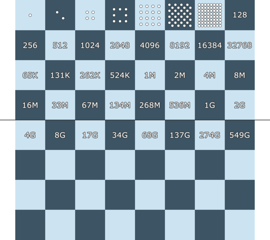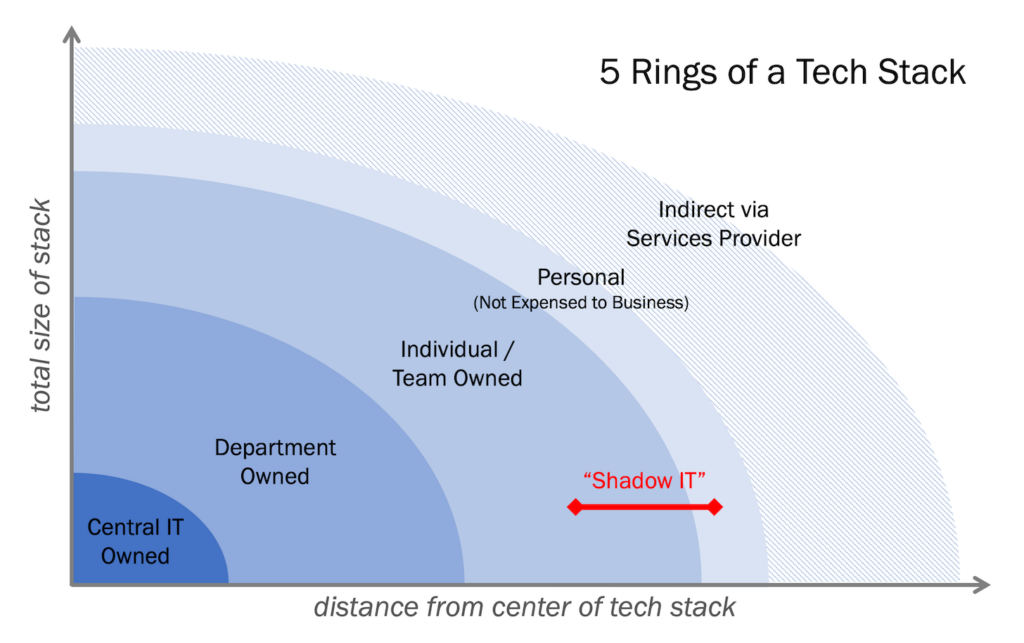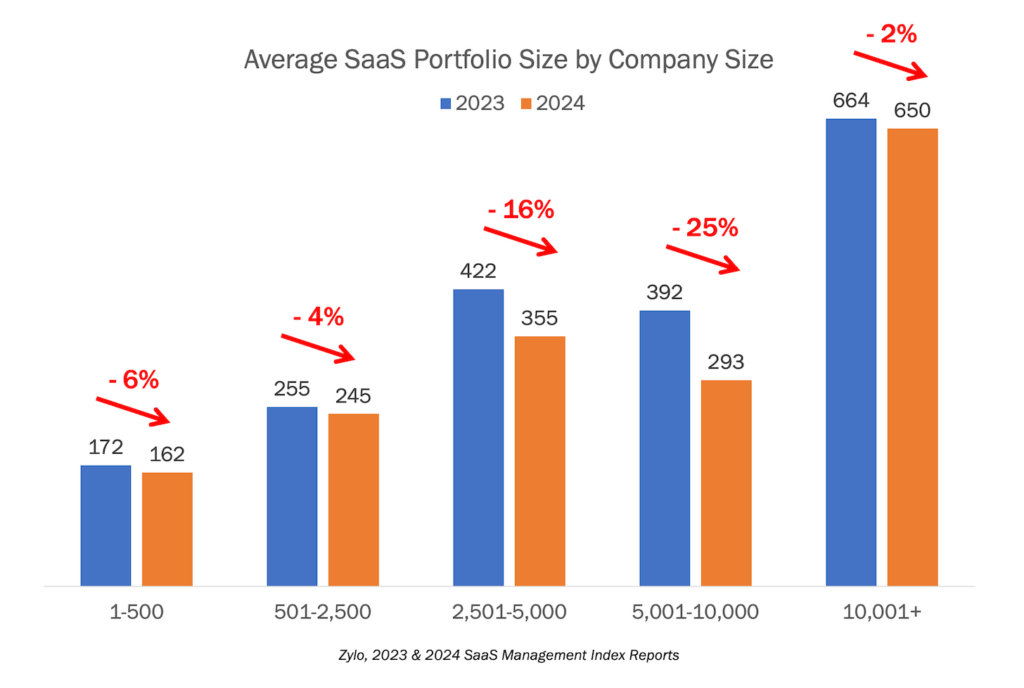Exponential growth in marketing is not just a colloquial way of saying, “wow, there’s an awful lot going on in marketing these days”. That’s true, of course, but I’m specifically fascinated by — and concerned about — actual mathematical exponential growth, where something doubles, doubles again, doubles again, and so on.
Let me start with the legend of the chessboard, as adapted from Wikipedia:
When the creator of the game of chess showed his invention to the ruler of his country, the king was so pleased that he gave the inventor the right to name his reward. The man, who was very clever, asked the king this: for the first square of the chess board, he would receive one grain of rice, two for the second square, four for the third, and so forth, doubling the amount each time for all 64 squares on the board.
The ruler, who was not strong in math, quickly accepted the inventor’s offer, even slightly offended by his perceived notion that the inventor was asking for so little. He ordered the treasurer to count and hand over the rice to the inventor.
However, when the treasurer took more than a week to calculate the reward, the king demanded a reason for his tardiness. The treasurer replied that it was impossible to fulfill the inventor’s request. By doubling the number of grains of rice 64 times, the inventor would be entitled to 18,446,744,073,709,551,615 grains of rice.
Or, put another way, if all of the Earth’s arable land was dedicated to producing rice, it would require more than 100 years of abundant harvests to deliver the reward.
The inventor thereby owned the entire kingdom.
So what does this have to do with marketing?
Online marketing is overflowing with ideas that contain exponential growth. Many of these ideas sound reasonable — and cool — when examined on a small scale. But as they start to ramp up, they quickly become monstrous. These are actually called Second Half of the Chessboard problems because, like our story above, the first few moves seem fine… but about halfway into it, you suddenly realize you’re in trouble. (“We’re going to need a bigger boat.”)
Consider this example from web marketing:
Multivariate testing (MVT) of elements on web pages, a topic I’ve talked about on ion’s post-click marketing blog (Playing Russian roulette with your landing pages?). At first, MVT sounds pretty cool: you load up a bunch of different headlines, images, offers, etc., into a web page, and then let the MVT software try different combinations to pick the best one.
But do the math. If you try 8 different headlines, 6 different subheads, 7 different images, 3 different body copy blocks, 3 different background colors, and 5 different offer buttons, that’s 8x6x7x3x3x5 = 15,120 possible combinations. Then, if you then consider 20 different ads and vehicles driving traffic there, that’s 20×1520 = 302,400 combinations. And what if you have 4 different audience segments you want to optimize individually for? Now you’re up to 302400×4 = 1,209,600 combinations. All of a sudden you might need 100 million or more respondents in order to reach statistical significance to determine what is a winning combination. This quickly becomes an unmanageable muddle.
Other examples include:
- The number of distinct marketing vehicles being engaged in Long Tail marketing campaigns. Think about all the keywords you might buy in a search marketing campaign. Then multiply by all the different creative ad variations you might try. Say it’s 250×20 = 5,000 today. Now, add a new campaign, and this can double overnight. Which means your reports and scope of analysis double overnight. But the hours in your day and the headcount on your team probably didn’t double.
- The growth of data analytics and behavioral tracking. Think about analyzing the “path” someone takes when they visit your web site. If your site has ~20 navigational choices on each page — some sites have hundreds! — then tracking the first 3 pages visitors go to has 20x20x20 = 800 possible paths. Maybe you think that’s not too bad, so you decide to look at the first 5 pages… which is suddenly 20x20x20x20x20 = 3,200,000 paths! Whoa. If you’re now trying to determine someone’s intention or segment from this huge pool of data, it’s nearly impossible to achieve statistical significance.
- The number of combinations in a chained sequence in marketing automation. A prospect goes from seeing an ad, to visiting a landing page, to receiving a white paper, to visiting your site, to getting a follow-up newsletter, to reading your blog, to being given a special offer, etc. The dream of marketing automation is to have this process flow with minimal intervention by the marketer’s staff, while each prospect feels like they’re getting individual and personalized attention. But like the web site paths in the previous example, every step added to the chain multiplies the number of possible combinations — quickly millions and billions and trillions — again making it essentially impossible to understand the exact dynamics of every interaction history. Closed-loop marketing is great in concept, but hard (NP-hard!) in practice.
- The viral explosion of a hot idea — or reputation crisis — in the social media sphere (i.e., they tell two friends, who each tell two friends, who each tell two friends, and so on).
- For you as a marketer, responsible for managing your company’s brand and channels in the world, the sheer number of things competing for your attention (the attention economy). Just when you thought you were getting search marketing under control, social media marketing is exploding. Do you have a Facebook strategy? Great. Now what about a Twitter strategy? Friend Feed strategy? Widget strategy? And now, whoops, Google has just changed their policy on landing pages, so you have to go back there. Your boss calls: what’s the current update on any one of these things?
Dizzying, isn’t it?
However, the first step to recovery is acknowledging the problem. Exponentials are most disruptive when they catch people by surprise. Don’t be the king with the chessboard problem.
Avoiding these areas where exponentials lurk isn’t an option either. You’re going to have to deal with campaign optimization, Long Tail marketing, large-scale web analytics, marketing automation, and viral effects in the marketplace.
So if you can’t ignore them, and you can’t avoid them, what do you do?
Here are some practical strategies — many adapted from computer science — for managing exponential growth in marketing problems:
- Know your ceiling and strategically stick to it. Like those signs on overpasses telling trucks how much clearance they have: low car, no problem; tall truck, big mess. Most exponentials are fine for the first few steps, so as long as you know in advance where the numbers go from being reasonable to unreasonable — and explicitly draw the line before they become unreasonable — you can work with combinatorial ideas. Don’t expect (or promise!) those techniques to scale beyond a focused, narrow window.
- Limit the number of multiplicative steps where you have control over them. Instead of engaging in multivariate testing of a web page with thousands of combinations, do a simple A/B split test to experiment with a new idea — it’s fast, easy, and clear to understand the outcome. Instead of using landing pages with full navigation — dozens of options on each page — temporarily narrow the choices presented to users to 2-5 relevant choices, at least for the first few pages. From the user’s perspective, this can be good context-relevant navigation. From your perspective as the marketer, this can reduce the number of “paths” being analyzed from an unmanageable exponential to a relatively tame one.
- Reduce the granularity from previous steps. For instance, you might have hundreds of ads driving to dozens of landing pages, all of which eventually generate leads that then need subsequent re-marketing. At the point you convert a respondent to a lead, you can grade them (A, B, C) and segment them into maybe 5 buckets. Now instead of having to directly deal with the thousands or millions of combinations in which a lead was created, the marketing automation logic at the next stage of the funnel only has to deal with 3 grades x 5 segments = 15 possibilities. This “reduction” process can happen again and again further down the pipeline. But be careful! This is a lossy one-way function: a B-grade respondent in a particular segment may have gotten there many, many different ways — and perhaps some incorrectly — so you have to balance your assumptions for how to deal with them accordingly.
- Only examine one thread of past choices at a time. For instance, looking at the choices a single person has made — which ads they responded to, what they did on the landing pages, what subsequent interactions they’ve had with your company — is reasonable. However, this means specifically looking at that one person’s history and not trying to generalize it into rules or predictions — because as soon as you do that, you’re back in the fire with explosive combinatorics.
- Intentionally drop things off the back end. If you keep giving a juggler more and more balls to coordinate in the air, eventually some are going to be dropped. But in marketing, not all balls are equal. Instead of dropping balls randomly — where, by Murphy’s Law, the most valuable ball is the one most likely to get dropped — consciously choose which balls are low priority, expendable. And let them go. For example, once certain previous campaigns have passed, remove them from your reports and analysis. I’m not saying that there might not be relevant data there — there very well may be — but if it’s not as relevant as other factors, take them out of your field of vision. Simplify to clarify.
- Techniques for managing continuous partial attention. This particularly applies to exponentials around the number of things you’re responsible for running well. It’s a different way of working, and new software and processes can facilitate or leverage it.
- Apply probabilistic and approximation algorithms to the problem. This last approach is arguably the most powerful, but it can also be easily misused — without evening knowing that it’s being misused. In this approach, the software doesn’t guarantee completely accurate results, but it takes its “best guess” by working with a random sample or subset of the data and extrapolating the results. This can be an acceptable trade-off, as long as you know what you’re trading off. What exactly is being randomized? How much margin of error is there? What are the consequences when a wrong guess occurs? I believe that one of the key advantages of bringing more computer scientists into the marketing domain will be incredible innovation with algorithms of this kind and better, safer intuition for understanding when and how to apply them.
So now, as the ruler of your marketing kingdom, hopefully you’re primed to ask the right questions — and use the right judgment for practical outcomes — when clever exponentials try to sneak by you. Be on the look out! In online marketing, they’re everywhere.
P.S. To keep exponentials in perspective: if you were to start with 1, double it to 2, double it again to 4, and keep doubling only 267 times, i.e. (2)^267, the result would be equal to the total number of atoms believed to be in the observable universe.



